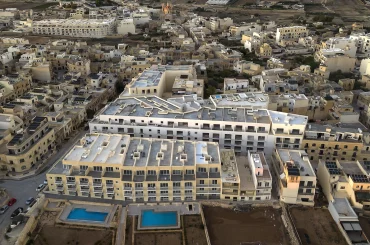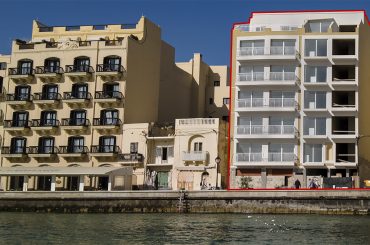The land at Tas-Sajtun on which the Planning Authority recently approved a large block of flats was registered at the Land Registry by an application that referred to other files, or applications, in which the basis deeds were supposedly appended. The basis deeds are the deeds (or contracts) that form the basis for the registration of land title.
In its application, the medieval foundation that registered ownership had two basis deeds: the deed that set up the foundation – called the Beneficcju ta Sant Antonio delli Navarra, set up in 1675 to raise money for pious deeds – and a contract drawn up in 2017. It was specified in the application for Tas-Sajtun that these deeds were “appended to LRA688/17”.
An investigation by this website can now reveal that LRA688/17 was an application for registration of unrelated piece of territory in another part of Gozo made by an unrelated entity – an entity within the Office of the Prime Minister.
This website went further, and tracked other applications of the foundation until it got to the application in which the deed that set up the foundation in 1675 was appended. And in that case this website found that the translation of the deed (the original was in Latin) had its first two pages omitted. These are the pages that described the lands placed in the foundation.
Yet the applications for land registration were still approved within days. In the case of Tas-Sajtun – a large territory amounting to almost four football pitches in size on which there had been some preexisting registrations by other individuals – the application for land title of ownership at the Land Registry was approved from one day to the next.

Approval of flats after a year of deferrals
The permit for the block of flats at Tas-Sajtun, situated on the edge of the development zone overlooking a valley, was published a month ago by the Planning Authority. The application elicited more than a thousand objections, and two separate legal appeals have been filed against the permit in the past two days.
The application was initially held up for several months after four environmental NGOs filed a judicial protest highlighting contestations of ownership after four individuals had claimed, in letters to the Planning Authority, to be owners of part of the land. The NGOs called on the Planning Authority to desist from processing the application.
Although the authority never replied to the judicial protest itself, the Planning Commission referred the issue to the Planning Authority’s legal office.
The legal office eventually cleared the way for the application to proceed after seeing documentation presented by Carmelo Galea, lawyer of the applicant and one of the shareholders of the company (Carravan Company Limited) that holds the land under emphyteutic lease. The legal office said that such documentation “satisfies Article 71(4) of Chapter 552 [planning law]”.
The principal documents submitted by Galea to the authority’s legal office were the applications for land title and the transfer of title or ownership approved by the Land Registry (as well as some previous land-holders’ renunciations of their holdings). The first of these was the application for registration made by the foundation on 14 February 2018, and the second was the subsequent transfer of the land title to Carravan Company Limited a year later.

In the application for ownership registration of Tas-Sajtun, submitted by Carmelo Galea on 14 February 2018 on behalf of the foundation, the basis for the application were the deed that set up the foundation in 1675 and the contract of 2017 signed between the archbishop and the siblings who claimed to be descendants of the foundation’s foundress, Cosmana Navarra. Galea’s application specified that those contracts were appended to a “previous application of the applicant on the territory ‘Tal-Andar il-Qadim in Qala, Gozo – LRA688/17”.
But LRA688/17, as already pointed out, had nothing to do with the medieval foundation or its lands, and there were no deeds appended to it. It was an application for land registration made by the Joint Office, a body within the Office of the Prime Minister which is responsible for managing land that the church passed to the State. The territory was not at Tal-Andar il-Qadim, it was at another part of Gozo miles away.

Translation of basis deed missing first two pages
This website also tracked the foundation’s separate application for the territory called “Tal-Andar il-Qadim,” also mentioned in the application for Tas-Sajtun.
The application for Tal-Andar il-Qadim also had the same two basis deeds, but these were not appended to the application. Reference was instead made to yet another application for a territory called Tal-Vardati, which is larger than the grounds of Mater Dei.
The two basis deeds were indeed appended to the application for Tal-Vardati. One of these is the deed or contract that set up the foundation in 1675. Three versions of it were appended to the application for Tal-Vardati: a photocopy of the original deed, which was handwritten in Latin and hardly legible; an unsigned typed version in Latin; and a Maltese translation made by Horatio Vella, a professor of Latin who teaches at the University of Malta. Vella had been commissioned to make the translation in the course of litigation in the late 1990s.
But the first two pages of the court-commissioned Maltese translation were omitted from the version attached to the land title application. It is in those two pages that the lands that Cosmana Navarra put in the foundation were described.

Tas-Sajtun land title approved in a day
The applications for land title mentioned in this article were approved within days. The applications for Tal-Andar il-Qadim and Tal-Vardati were both filed on 25 July 2017, and were approved on 2 August and 4 August respectively.
In the case of Tas-Sajtun, where the Planning Authority approved the block of flats, the application for ownership registration was approved on 15 February 2018, the day after it had been submitted.

All of these were approved by the former Assistant Land Registrar for Gozo, Marlin Vella.
This website consulted several notaries, and all said that the Land Registry would typically ask for further information or documentation if anything was amiss in a document or documents that formed the basis for the application.
This website reached out to Vella for comment. Contacted on the phone, he proceeded to cut the conversation short and hang up. Questions were then sent via text message, but he did not respond.
Vella left the Land Registry in 2021, partly because of the controversy he found himself in after he approved the foundation’s application for land registration in the centre of Nadur in early 2019, on an area on which dozens of houses sit.
He now works for Kristen Dimech, a notary who has handled some of the deeds made by the foundation in recent years, as well as some of the sales deeds of flats in the development of an area called Ta Ghar Boffa into a sprawling block of flats. Ta Ghar Boffa, which is larger than three football pitches, belonged to the foundation before being transferred via emphyteutic deed to Carravan Company Limited. The latter in turn passed it on to Excel Investments Limited, a company belonging to Joseph Portelli and two other partners. Carravan has made millions from the development of more than 150 flats being built at Ta Ghar Boffa. (There is currently a development application to extend the development even further.)

A request for comment was also sent to Carmelo Galea, one of the directors and shareholders of Carravan who signed the applications for registrations made by the foundation. He was asked if he had a comment to make on this website’s findings, including the wrong or incorrect reference made in the application of Tas-Sajtun as to where the two basis contracts or deeds where supposedly appended, and the copy of the Maltese translation of the 1675-deed that had been reproduced from court file having the first two pages omitted.
The email was sent at noon last Friday, and he was given until the end of the following day to answer.
He replied: “Your assumption that I would be able to find the time to reply and provide you with the information that you require by tomorrow is sadly grossly misplaced. I simply will not have the necessary time to find the documents and reply to you within such a short period of time.”
Donate to Gozo Grab Investigation
The investigations into the Gozo grab saga require huge effort and resources, and this website relies on donations to fund journalistic investigations. This website's donation setup itself is uniquely transparent, with targeted amounts that allow tracking of donations in real time on the page. Yet donations for these investigations has been pitiful despite extremely modest targets. Contribute as little as €5 to sustain the Gozo grab investigative series.




